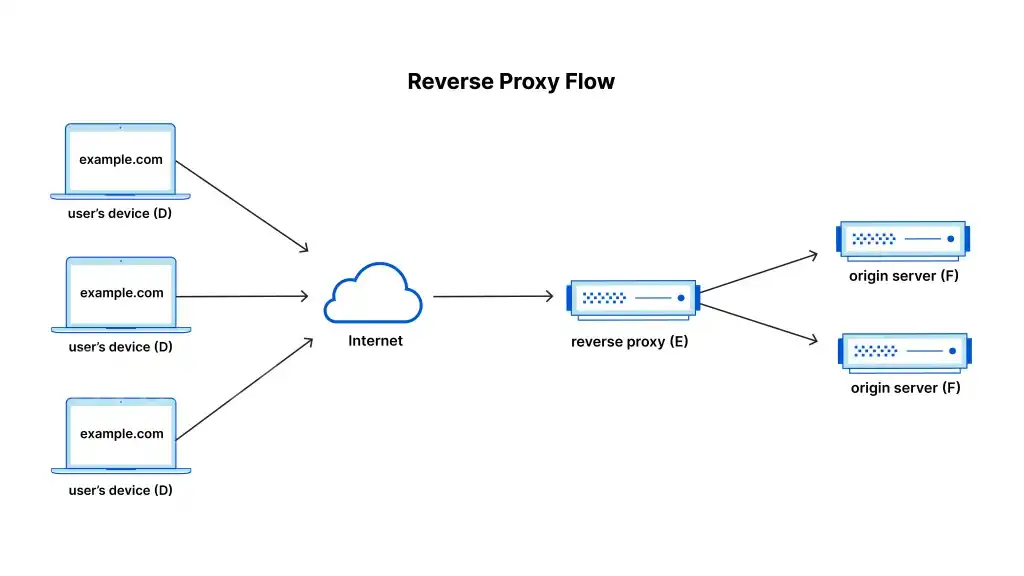In today’s digital landscape, website security and performance are crucial factors that organizations need to prioritize. One key technology that helps achieve these goals is a reverse proxy server. But what exactly is a reverse proxy server?
A reverse proxy server acts as an intermediary between client devices and web servers. Unlike a traditional proxy server that forwards client requests to the internet, a reverse proxy server receives requests from clients and redirects them to the appropriate backend server. In simpler terms, it acts on behalf of the server and shields it from direct client connections.
Reverse proxy servers play a vital role in managing web traffic and enhancing website security. By providing an additional layer of protection, reverse proxy servers safeguard backend servers from unwanted access and potential attacks, such as DDoS (Distributed Denial of Service) attacks. Additionally, they optimize network traffic by distributing requests across multiple servers, ensuring efficient load balancing and improved website performance.
In the following sections, we will delve deeper into how a reverse proxy server works, the benefits it offers, real-world examples of its implementation, and a step-by-step guide on configuring and setting up a reverse proxy server. By understanding the fundamentals of reverse proxy servers, businesses can leverage this technology to bolster their online presence and ensure a secure and seamless user experience.

Table of Contents
ToggleHow Does Reverse Proxy Server Work?
In this section, we will delve into the inner workings of a reverse proxy server and explore how it functions to manage web traffic efficiently. By intercepting and forwarding client requests, balancing the load, and utilizing caching capabilities, reverse proxy servers play a crucial role in enhancing overall website performance.
Intercepting and Forwarding Client Requests
A reverse proxy server acts as an intermediary between client devices and backend servers. When a client sends a request to access a website, the reverse proxy server intercepts the request and forwards it to the appropriate backend server. By doing so, the reverse proxy server hides the backend server’s identity, providing an extra layer of security.
Load Balancing
One of the primary functions of a reverse proxy server is load balancing. It distributes incoming client requests across multiple backend servers, ensuring even distribution of the workload. This results in improved server performance, high availability, and optimal resource utilization.
Caching Capabilities
A reverse proxy server can also cache frequently accessed content. When a client requests a specific resource, the reverse proxy server checks its cache first. If the requested content is present in the cache, the reverse proxy server serves it directly to the client, reducing the load on the backend servers and significantly improving response times.
In summary, a reverse proxy server works by intercepting and forwarding client requests, balancing traffic load, and utilizing caching capabilities. By implementing this powerful tool, businesses can ensure seamless website performance, improved security, and enhanced user experience.
Benefits of Using a Reverse Proxy Server.
Implementing a reverse proxy server can provide numerous advantages for businesses. Let’s explore the benefits of using a reverse proxy server and compare it to a forward proxy server.
Enhanced Website Security
- A reverse proxy server acts as a defensive shield, protecting the backend infrastructure from direct access by clients.
- By intercepting and filtering client requests, it becomes an additional layer of security, preventing direct communication with servers.
- Reverse proxy servers allow for SSL/TLS termination, enabling encryption and decryption of traffic.
- This added security measure minimizes the risk of data breaches and unauthorized access to sensitive information.
Reduced Server Load
- Reverse proxy servers distribute client requests across multiple servers, balancing the traffic load and preventing any single server from becoming overwhelmed.
- This load balancing capability ensures optimal performance, even during peak traffic periods.
- By efficiently managing server resources, reverse proxy servers can improve response times and maintain high availability.
Optimized Network Traffic
- A reverse proxy server caches frequently accessed content, reducing the need for repeated requests to backend servers.
- By serving cached content, network bandwidth is conserved, resulting in faster response times and improved user experience.
- Reverse proxy servers also offer advanced traffic optimization techniques such as compression and content delivery network (CDN) integration, further enhancing performance.
When compared to forward proxy servers, reverse proxy servers offer distinct benefits that cater specifically to website security, server load management, and network traffic optimization. By leveraging these advantages, businesses can enhance website performance, improve user experience, and ensure a secure online environment.
Reverse Proxy Server Examples.
When it comes to implementing a reverse proxy server, there are several popular software options that have been widely used by organizations to improve website performance and scalability. Let’s take a look at some of the top reverse proxy server software:
- NGINX: NGINX is a well-known reverse proxy server software that offers high-performance load balancing, caching, and SSL/TLS termination capabilities. It is highly scalable and can handle heavy traffic loads efficiently.
- Apache HTTP Server: Apache HTTP Server is another popular choice for reverse proxy server deployments. It provides a robust and customizable solution with various modules that can be configured to meet specific requirements.
- HAProxy: HAProxy is a lightweight and powerful load balancer and reverse proxy server software. It offers high availability, SSL termination, and session persistence, making it suitable for demanding environments.
- Varnish Cache: Varnish Cache is a reverse proxy server software that focuses on caching and accelerating web content delivery. It provides excellent performance and can significantly improve website response times.
These are just a few examples of the top reverse proxy server software available in the market. Each software has its own unique features and strengths, allowing businesses to choose the one that best fits their specific needs and requirements.
Configuring a Reverse Proxy Server.
Setting up a reverse proxy server may seem daunting, but with the right guidance, it can be a straightforward process. This section provides a step-by-step guide on how to configure and set up a reverse proxy server, ensuring a seamless deployment for your website.
-
- Choose the Right Software: Start by selecting a reliable reverse proxy server software that suits your requirements. Options like Nginx, Apache HTTP Server, and HAProxy are popular choices due to their robust features and extensive community support.
- Install and Configure the Software: Once you have chosen the software, follow the installation instructions provided by the vendor. After installation, configure the reverse proxy server according to your network and website’s specific needs. This typically involves modifying the configuration files with the appropriate settings.
- Set Up Virtual Hosts: Configure virtual hosts in the reverse proxy server to handle different domain names or subdomains. This allows the reverse proxy server to direct incoming traffic to the appropriate backend servers based on the requested URL.
- Implement SSL/TLS Encryption: Enhance the security of your website by enabling SSL/TLS encryption. Generate or obtain an SSL/TLS certificate and configure the reverse proxy server to use it. This ensures that all communication between the client and the reverse proxy server remains confidential and secure.
- Configure Load Balancing and Caching: Depending on your website’s traffic and performance requirements, configure load balancing algorithms to distribute incoming requests across multiple backend servers. Additionally, enable caching to store frequently accessed content closer to the client, improving response times and reducing server load.
By following these steps and customizing the configuration based on your specific needs, you can successfully configure and set up a reverse proxy server. With a properly configured reverse proxy server, you can optimize your website’s performance, enhance security, and efficiently manage incoming web traffic.
Conclusion
In conclusion, reverse proxy servers play a crucial role in ensuring website security, improving performance, and optimizing network traffic. By intercepting and forwarding client requests, these servers act as a protective shield, safeguarding important assets and mitigating potential threats.
Furthermore, the use of reverse proxy servers allows businesses to efficiently balance incoming traffic, distribute workload across multiple servers, and reduce the chances of server overload. This contributes to a seamless user experience, as website visitors can enjoy faster load times and improved overall performance.
Moreover, reverse proxy servers provide caching capabilities that reduce the burden on backend servers by serving cached content, resulting in quicker response times and improved scalability. This not only enhances website performance but also saves server resources and bandwidth, leading to cost savings and higher efficiency.
By gaining a comprehensive understanding of reverse proxy servers and their benefits, businesses can make informed decisions when it comes to their online presence. Implementing a reverse proxy server can contribute to a more secure, efficient, and reliable website, ultimately boosting customer trust, satisfaction, and overall success.
FAQ
What is a reverse proxy server?
A reverse proxy server is a server that sits between client devices and web servers. It receives client requests and forwards them to the appropriate web servers. Unlike a traditional forward proxy server, which protects client devices, a reverse proxy server protects web servers from direct client connections.
How does a reverse proxy server work?
When a client sends a request to access a website, it is intercepted by the reverse proxy server. The reverse proxy server then evaluates the request, determines the appropriate web server to handle it, and forwards the request to that server. The reverse proxy server also performs tasks such as load balancing, caching, and SSL encryption to enhance website performance and security.
What are the benefits of using a reverse proxy server?
Using a reverse proxy server offers several benefits. It improves website security by acting as a shield between clients and web servers. It reduces server load by distributing incoming requests across multiple servers. Additionally, a reverse proxy server optimizes network traffic by caching content and serving it to clients, enhancing website performance.
Can you provide some examples of reverse proxy server software?
Some popular reverse proxy server software options include Nginx, Apache HTTP Server, HAProxy, and Microsoft Application Request Routing (ARR). These software options are widely used and offer a range of features to effectively manage web traffic and enhance website performance.
How do I configure a reverse proxy server?
Configuring a reverse proxy server involves several steps. First, you need to choose the right software for your needs. Then, you need to configure the software with the appropriate settings, including specifying the backend web servers and defining rules for traffic routing. It is also crucial to optimize the server for performance, considering factors such as caching and SSL encryption.
















